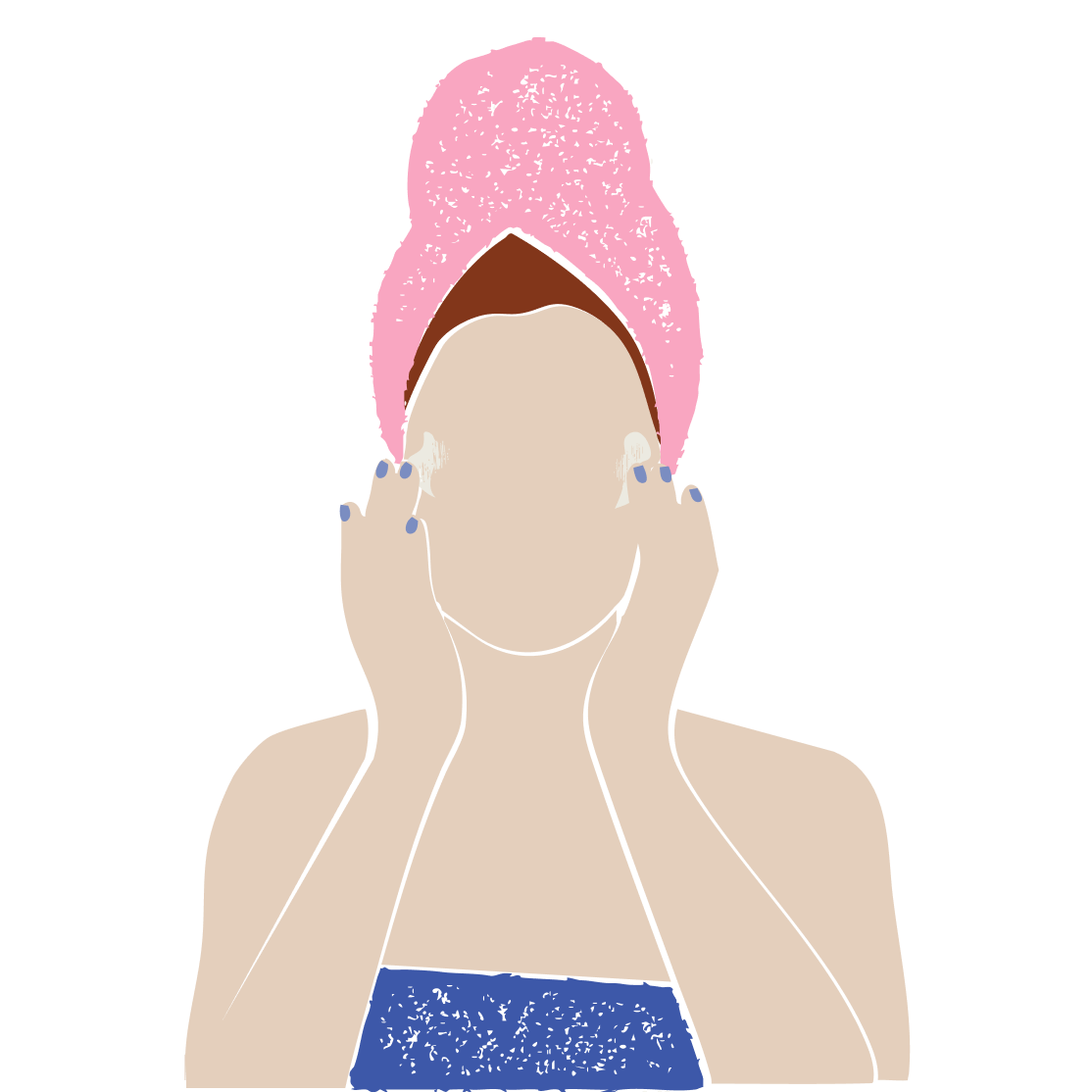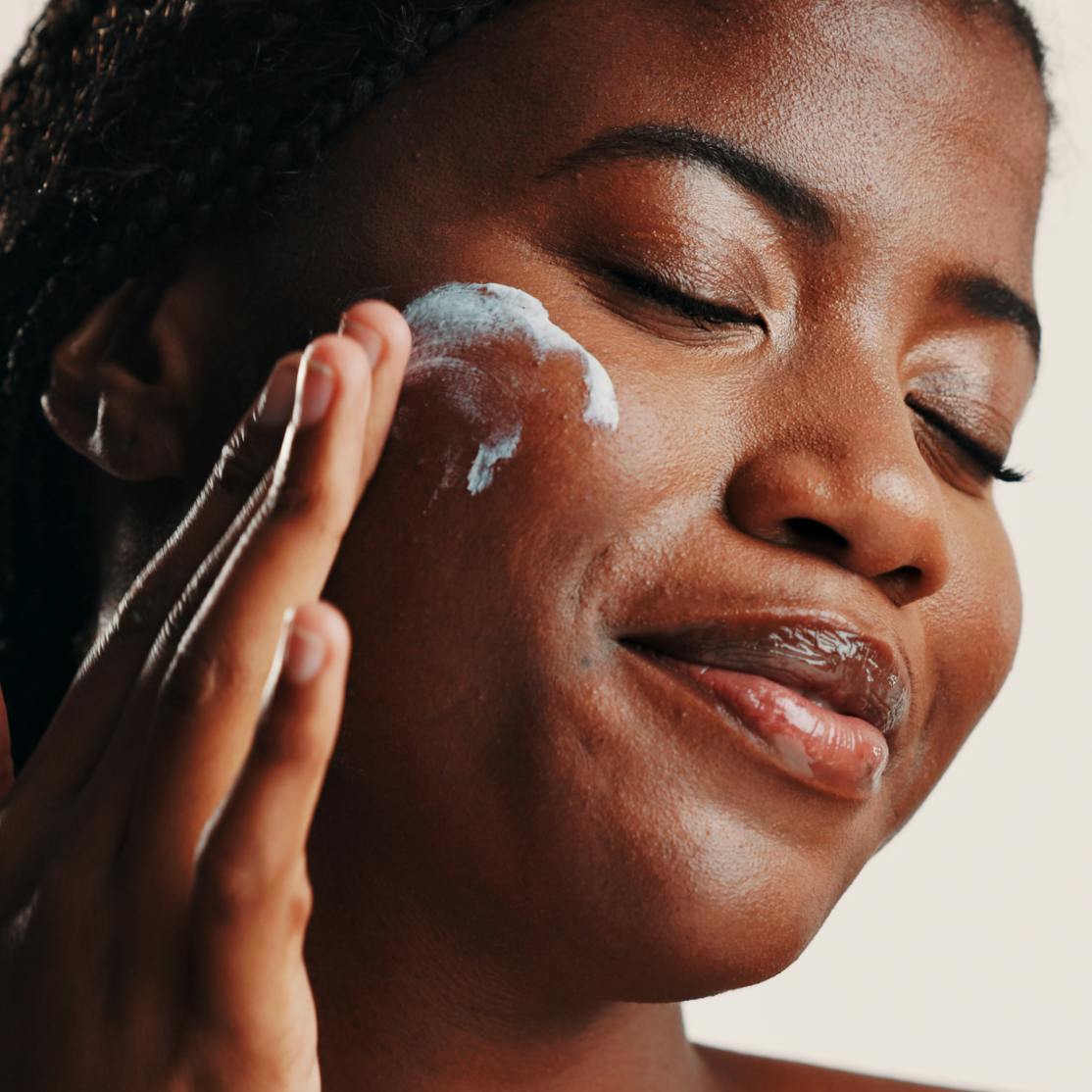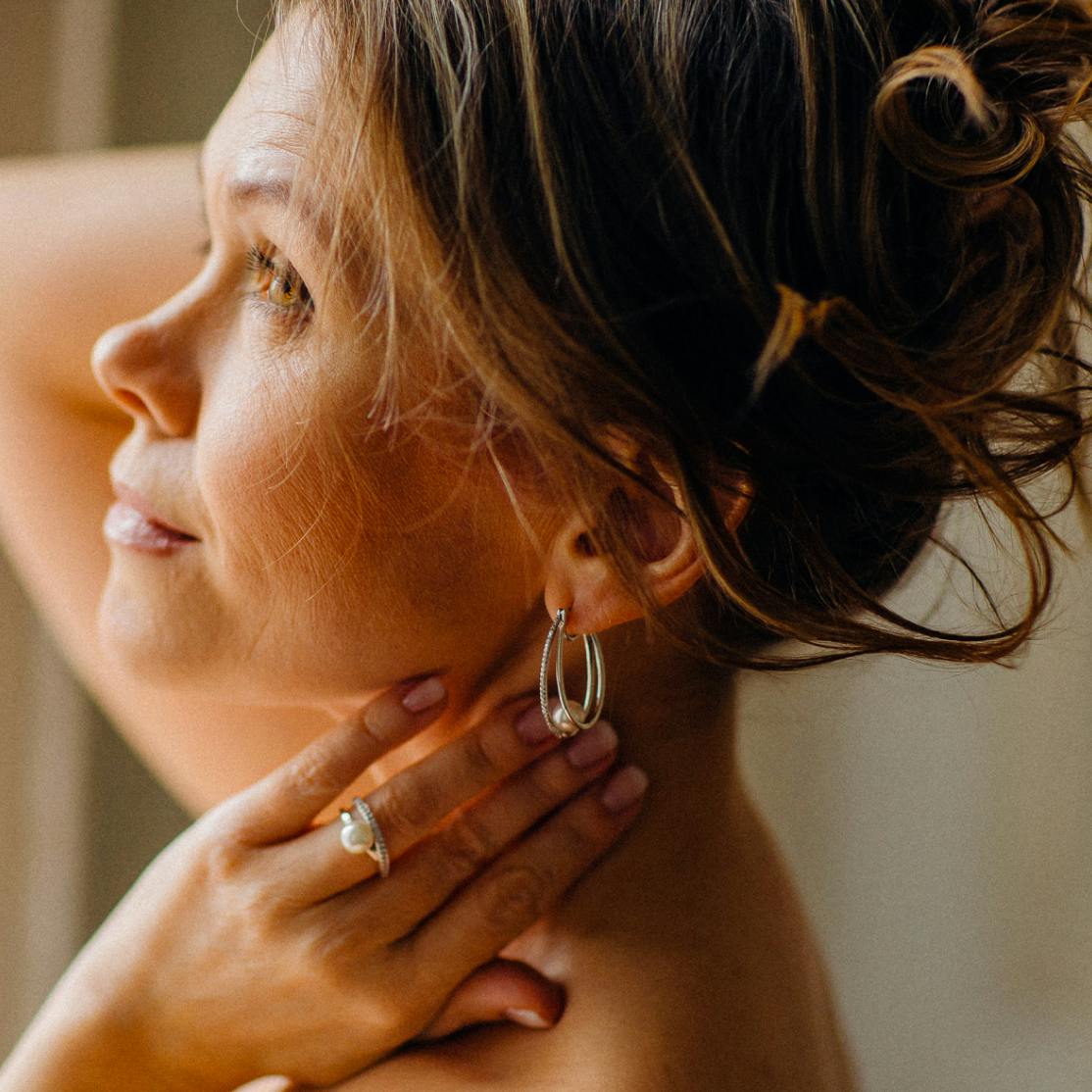Finding the best moisturizer for aging skin feels like searching for the fountain of youth in a jar—everyone claims to have it, but the results don't always live up to the hype. Whether you're battling your first fine lines or looking for something to tackle deeper wrinkles, the right moisturizer can make a world of difference in how your skin looks and feels. After trying countless formulas and consulting with experts, we've rounded up the best ingredients for face moisturizers for aging skin that actually deliver results.
Remember when you could wash your face with whatever soap was in the shower, slap on some random lotion, and still look fresh-faced by morning? Those were the days. As we age, our skin starts sending increasingly desperate SOS signals in the form of fine lines, wrinkles, and dryness that no amount of water seems to quench.
Aging skin isn't just about wrinkles—it's about fundamental changes in how our skin functions. The fountain of collagen that keeps everything plump and bouncy starts to run dry, and our natural moisture barrier weakens like an aging dam.
A good moisturizer isn't just a nice-to-have anymore; it's one of your skin's best defenses against time. The best moisturizer for aging skin wears many hats—holding in moisture, supporting collagen production, and creating a protective barrier against environmental damage that accelerates aging. Let's dive into what makes a moisturizer worthy of your skin's attention.
How Aging Affects the Skin
The Collagen/Elastin Collapse
Think of collagen as the scaffolding that keeps your skin looking like it's defying gravity. From your mid-20s onward, your skin will lose about 1% of its collagen each year. “Low estrogen causes a 30% decline of your skin's collagen in the first five years of menopause,” says Lauren Streicher, MD, a is a clinical professor of obstetrics and gynecology at Northwestern University’s Feinberg School of Medicine, which explains why things that once pointed up now point decidedly down. “It also leads to a decrease in elastin,” says Dr. Streicher, “the protein responsible for keeping skin nice and taut, instead of stretched out like a rubber band.”

The Great Moisture Drought
Remember how your teenage skin produced enough oil to fry an egg? That same skin will eventually become as dry as the toast to go with it. After 40, sebum (oil) production drops significantly, especially for women in menopause. Without this natural lubricant, skin becomes drier, more sensitive, and less able to maintain its moisture barrier—think of it as your skin forgetting how to keep itself hydrated.
The Slowdown Effect
Cell turnover—that magical process where your skin sheds old cells and creates fresh ones—slows down dramatically with age. In your 20s, this renewal happens every 28 days or so. By your 50s and beyond, it can take much longer. The result? Dull skin that holds onto dead cells much longer, making your complexion about as radiant as a rainy Monday. By the way, “all these changes are not just limited to the skin on your face,” says Dr. Streicher. “It happens to your skin everywhere. But it’s just the most obvious on your face, and in many cases the most dramatic since your face is also reflecting the impact of years in the sun.”
The Thinning of the Guard
Your skin's barrier function—its ability to keep good things in and bad things out—also weakens with age. Decreased estrogen means the skin actually becomes thinner, with the epidermis losing about 6.4% of its thickness every decade. “There’s also decreased blood flow to the skin, which is why your skin is thinner, dryer, and more vulnerable to bruising, irritation, and dehydration,” says Dr. Streicher. You may also notice that your skin doesn't heal as fast from little nicks either, so it’ll break down more easily and heal more slowly.
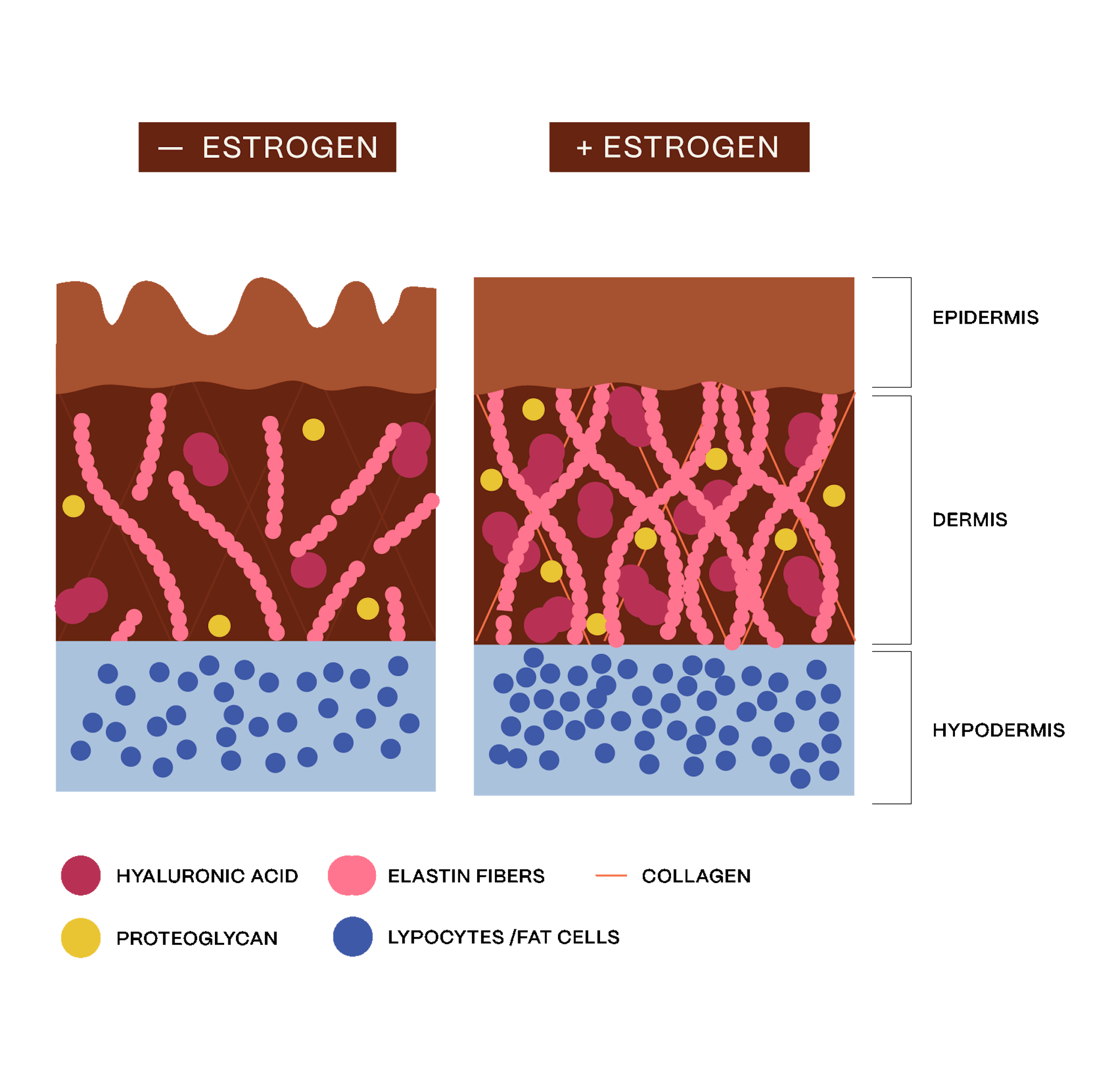
7 Key Ingredients to Look for in Moisturizers for Aging Skin
Hyaluronic Acid
This moisture-binding superstar can hold up to 1,000 times its weight in water. Think of it as a molecular sponge that plumps your skin with hydration from within. As we age, our natural hyaluronic acid production decreases, making topical application all the more important.
Retinol & Retinoids
The closest thing skincare has to a time machine, retinol helps increase cell turnover and stimulate collagen production. Retinoid is a term for a range of vitamin A-based products for skin. Retinol is used to improve uneven skin tone, pigmentation, and texture and it’s available over the counter; tretinoin, aka Retin-A is available by Rx. The downside? Retinols can be irritating at first. Start with a low concentration every few days and work your way up to nightly use for maximum wrinkle-fighting benefits.
Peptides
These small protein fragments work like tiny messenger systems, signaling your skin to produce more collagen. Unlike retinol, peptides rarely cause irritation, making them ideal for sensitive skin types that want anti-aging benefits without the drama.
Ceramides
These lipid molecules are essentially the mortar between your skin cell "bricks," keeping your moisture barrier intact and preventing dehydration. They're the unsung heroes of anti-aging skincare—not as flashy as some ingredients, but absolutely essential for maintaining skin that looks healthy rather than parched. Research shows that ceramide levels in skin decrease with age, making supplementation through skincare crucial.
Antioxidants
Free radicals from pollution, UV exposure, and other environmental stressors contribute significantly to premature aging. Vitamin C, E, and niacinamide are like your skin's personal bodyguards, neutralizing free radicals before they can cause oxidative damage.
Sunscreen
Not technically a moisturizing ingredient, sunscreen is absolutely essential in any daytime anti-aging product. UV damage is responsible for approximately 80% of visible facial aging. That's right—all those expensive serums and treatments are fighting a battle that could largely be prevented with consistent sunscreen use. Not wearing SPF every day is like having a state-of-the-art security system but leaving your front door wide open. “Any dermatologist will tell you the product which is most important to keeping skin youthful is sunscreen, ideally starting around age 20. I know it's too late for us, but tell your daughters!” says Dr. Streicher. The American Academy of Dermatology recommends an SPF of 30 or higher. And make sure the products you use are broad spectrum, meaning they block both UVA and UVB rays.
Shea Butter & Glycerin
These humectants and emollients provide deep hydration and create a protective barrier that locks in moisture. They're particularly effective for extremely dry, mature skin that needs intensive care—those patches that look like you've been basted with flour and left to dry in the sun.
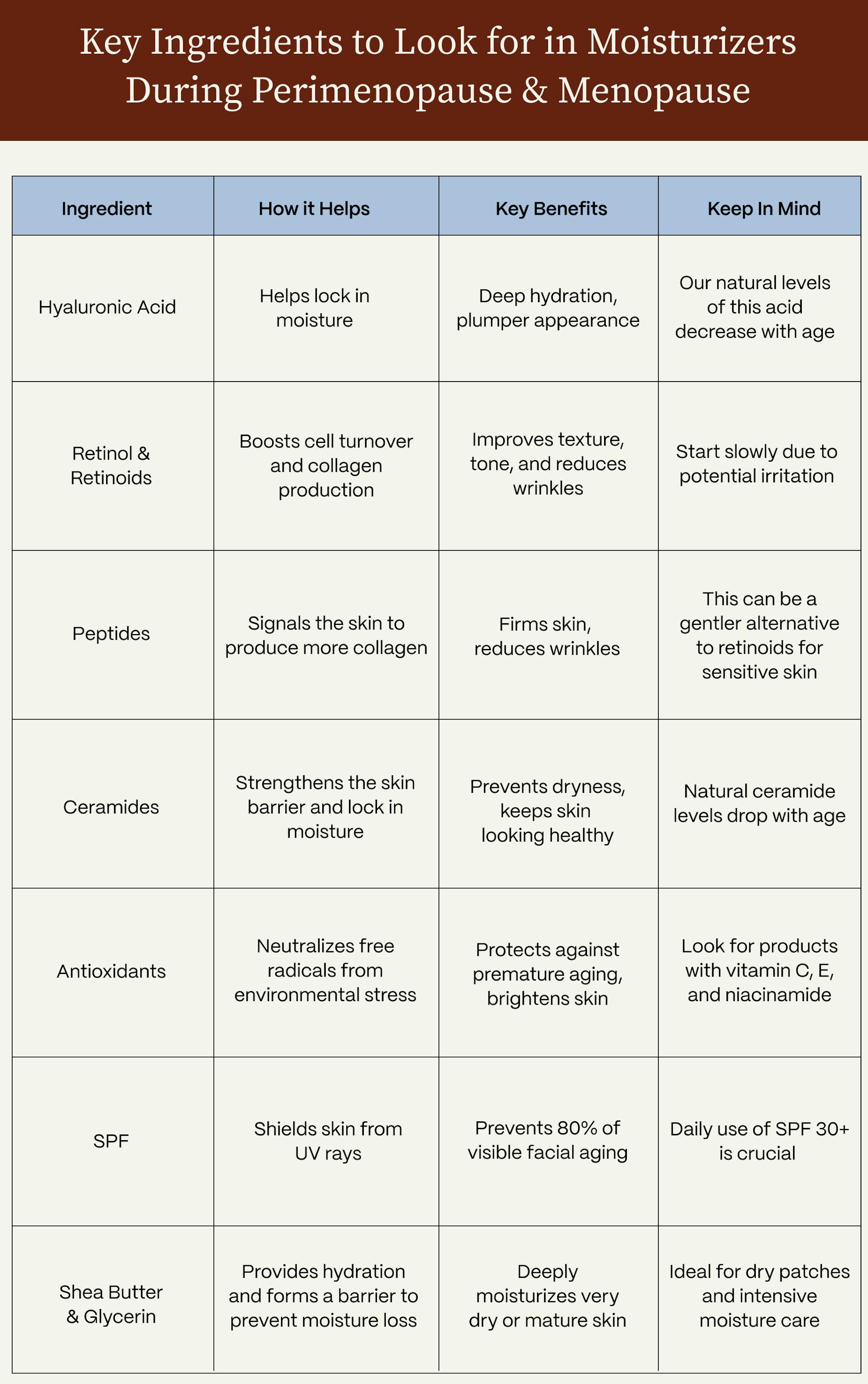
Best Moisturizers for Aging Skin by Skin Type
For Dry Skin
If your skin feels tight and uncomfortable even after moisturizing—like you're wearing a mask that's two sizes too small—you need heavy-duty hydration. Opt for rich, cream-based formulas with ceramides, shea butter, and hyaluronic acid. These ingredients create a luxurious moisture sandwich, with different components working at various skin levels to restore hydration from the inside out.
Look for products labeled "rich," "replenishing," or "ultra-hydrating." These formulations typically have a higher oil content and create a protective barrier that prevents moisture loss.
For Oily Skin
Yes, even oily skin needs moisture as it ages! The trick is finding lightweight, non-comedogenic formulas (won’t clog pores) that hydrate without turning your face into a slip 'n slide. Look for gel creams, lotions, or "oil-free" moisturizers that contain hyaluronic acid and niacinamide. These ingredients provide hydration while helping to regulate sebum production.
For Combination Skin
Skin that’s dry in some areas and oilier in others (like the T-zone) can be tricky to treat as you balance different needs in different areas while simultaneously trying to address the all-over effects of aging. Consider using a lighter formula across your entire face, with a richer product layered on dry areas. Think of it like having climate control settings for different parts of your face.
Gel-cream hybrids often work well for combination skin, providing enough moisture for dry cheeks while not overwhelming the oilier areas. It's about finding that "just right" middle ground that tackles aging concerns without creating new ones.
For Sensitive Skin
If your skin reacts to new products faster than you can say "return policy," you need gentle, fragrance-free formulations. Look for moisturizers containing “calming” ingredients like colloidal oatmeal, allantoin, and ceramides, which strengthen your skin barrier without irritation.
Avoid common irritants like alcohol, synthetic fragrances, and high concentrations of active ingredients. Sensitive skin doesn't mean you can't address aging—it just means you need to take a gentler, more patient approach.
Best Moisturizers for Aging Skin by Concern
For Deep Wrinkles
Moisturizers containing retinol or prescription retinoids, alongside peptides and growth factors, can help rebuild collagen from within. These ingredients don't just hydrate—they actively work to remodel the skin's structure, like renovation contractors for your face.
Look for products specifically targeting "deep wrinkles" or "advanced aging," which typically contain higher concentrations of active ingredients. Pair these with consistent SPF use.
For Fine Lines & Early Signs of Aging
For those just noticing the first whispers of aging (or wisely starting preventative care), lighter formulations with peptides, antioxidants, and mild exfoliating ingredients can make a significant difference. These products focus on preservation and prevention.
Ingredients like bakuchiol (a gentler, plant-based retinol alternative) and vitamin C can help keep skin firm and bright while preventing further damage. It's the skincare equivalent of "a stitch in time saves nine"—address those fine lines early, and you may never need to worry about the deep ones.
For Dull, Uneven Skin Tone
If your complexion has lost its radiance, look for brightening moisturizers with vitamin C, niacinamide, and gentle AHAs (Alpha-Hydroxy Acids) like lactic acid. These ingredients work to fade dark spots, even out pigmentation, and gently exfoliate for a more luminous appearance.
Products labeled "brightening" or "radiance-boosting" typically address this concern, often incorporating subtle light-reflecting particles for an immediate glow while the active ingredients work their magic over time.
For Sagging Skin
When gravity becomes your number one enemy, moisturizers containing peptides, and firming ingredients like caffeine can temporarily tighten and lift the appearance of skin. While no topical product can replace a surgical facelift, the right formulation can improve skin resilience and elasticity over time.
Look for terms like "lifting," "firming," or "sculpting" on product labels. These moisturizers often have a slightly tightening effect when applied, providing both immediate satisfaction and long-term benefits.
Day vs. Night Moisturizers: Do You Need Both?
Day Creams: Your Skin's Bodyguard
Daytime moisturizers should focus on protection—SPF to shield from UV damage, antioxidants to neutralize free radicals, and lightweight hydration that works well under makeup. Think of them as your skin's personal security detail, standing guard against the daily onslaught of environmental aging factors.
The best day creams for aging skin absorb quickly without leaving a greasy residue, while still providing enough moisture to keep your makeup from settling into fine lines by lunchtime.
Night Creams: Your Skin's Repair Crew
Nighttime is when your skin shifts into repair mode, making it the perfect time to apply richer, more active formulations. Without the need to worry about sun sensitivity or makeup compatibility, night creams can contain higher concentrations of ingredients like retinol, glycolic acid, and peptides.
These products are typically richer and more occlusive, creating an environment where active ingredients can penetrate deeply and work effectively. Think of your night cream as the construction crew that comes in after hours when everyone has gone home—doing the major repair work while you sleep.
The Layering Strategy
For optimal results, consider the "skincare sandwich" approach: a serum targeted to your specific concerns, followed by a moisturizer appropriate for the time of day, and (for nighttime) potentially sealed with a facial oil if extra hydration is needed. This strategic layering ensures you're addressing multiple aspects of aging skin while maintaining proper hydration.
Remember, consistency is key—the best anti-aging routine is the one you actually stick with. It's like exercise: better to do a moderate routine regularly than an intensive one once in a blue moon.
Best Anti-Aging Moisturizers for Your 30s, 40s, 50s+
In Your 30s: Prevention is the Name of the Game
Your 30s are when you might start noticing the first signs of aging—a fine line here, slightly duller skin there. This is the perfect time to focus on prevention with antioxidant-rich moisturizers and daily SPF. It's like starting a retirement account early—the small investments now pay huge dividends later.
Look for lightweight formulas with:
- Vitamin C
- Niacinamide
- Hyaluronic acid.
You might not need the heavy-hitting wrinkle fighters yet, but creating a strong foundation of hydration and protection will delay their necessity.
In Your 40s: Strategic Intervention
By your 40s, collagen loss accelerates and cell turnover slows down more noticeably. Your moisturizer should contain ingredients that actively stimulate collagen production and speed up cell renewal, like peptides, retinol, and growth factors. This is when to start bringing out the more sophisticated tools—less Swiss Army knife, more specialized equipment.
Hydration becomes even more crucial as natural oil production decreases. Look for moisturizers that combine anti-aging actives with more substantial hydration.
In Your 50s & Beyond: Intensive Support
After 50, the skin's ability to retain moisture decreases significantly, and all signs of aging become more pronounced. This is when to embrace rich, nutrient-dense moisturizers with multiple peptides, advanced ceramide complexes, and possibly prescription-strength retinoids (via your dermatologist).
These powerhouse products focus on supporting your skin's changing needs—like switching from regular maintenance to restorative care for a vintage car. Don't be afraid of richer textures and oil-based formulations; what might have felt too heavy in your younger years could be just what your skin craves now.
How to Apply Moisturizer for Maximum Effectiveness
The Damp Skin Trick
Want your moisturizer to work twice as hard? Apply it to slightly damp skin. This allows the humectants in your formula to grab onto that surface moisture and pull it into the skin. This simple change can dramatically improve how well your product absorbs and hydrates.
For best results, apply your moisturizer within three minutes after cleansing or misting your face. It's a small window of opportunity that makes a big difference in results.
Upward and Outward
The direction of application matters more than you might think. Using gentle upward and outward strokes not only prevents dragging the skin downward (which can emphasize sagging over time) but also helps stimulate lymphatic drainage and boost circulation. Think of it as natural contouring—helping your face fight gravity with every application.
Pay special attention to areas that show age first—the lower cheeks, jawline, and neck deserve just as much care as your forehead and eyes. It's like real estate—location matters, and some areas need more investment than others.
Layer Like a Pro
Moisturizer often works best as part of a team. For aging skin, consider this sequence:
- toner or essence (to prepare the skin)
- serum (targeted treatment)
- moisturizer (hydration and sealing)
- facial oil, if needed (extra nourishment).
This strategic layering ensures each product can perform its specific function while supporting the others.
Don't Forget the Supporting Cast
Your neck, décolletage, and hands reveal your age just as much as your face—sometimes more so because they're often neglected. Extend your moisturizing routine downward, or invest in specific products for these areas, which may have different needs than facial skin.
Clinician-Recommended Best Moisturizers for Aging Skin
Hydrating Heavyweights
For seriously parched mature skin, look for moisturizers containing multiple weights of hyaluronic acid, ceramide complexes, and natural oils. These formulations create a moisture reservoir within the skin, providing both immediate relief and long-term hydration benefits. They're like having an internal sprinkler system for your face—keeping everything green and lush even in drought conditions.
The best versions feel surprisingly non-greasy despite their intense hydrating properties, absorbing effectively to leave skin plump and dewy rather than shiny or tacky.
Anti-Aging Powerhouses
When wrinkles and sagging are your primary concerns, opt for moisturizers containing peptide complexes, retinol or retinol alternatives, and growth factors. These scientifically advanced formulations don't just cover problems—they actively work to reverse them by stimulating your skin's natural repair mechanisms.
Look for products backed by clinical studies rather than just glowing testimonials. The best anti-aging creams have measurable results in reducing wrinkle depth, improving firmness, and enhancing skin elasticity. They're the difference between an Instagram filter and actually having better skin in real life.
SPF Superstars
The best anti-aging product is, was, and always will be sunscreen. But not all SPF moisturizers are created equal, especially for mature skin that needs hydration along with protection. Look for broad-spectrum (UVA/UVB) SPF 30+ formulations that also include antioxidants (for additional environmental protection) and hydrating ingredients.
The most elegant formulations protect without the telltale white cast, greasiness, or pilling under makeup that plagued older sunscreen products.
Overnight Sensations
Night creams for aging skin should deliver serious restoration while you sleep. The best ones contain ingredients like peptides, retinol, and rich but non-comedogenic oils that work with your skin's natural nighttime repair processes.
These products typically have a richer texture that creates a protective veil over the skin, preventing moisture loss throughout the night while active ingredients penetrate deeply.
Estriol Face Cream
Among targeted treatments, estriol face cream deserves special attention. Topical use of estrogen has been shown to improve collagen and elastin levels in menopausal women, as well as moisturizing the skin. When applied to the face, estriol can help minimize fine lines, plump and tighten skin. More research is needed, but one small study found that topical estriol can increase skin firmness by up to 61% and skin hydration by 38% after just 16 weeks of use. In another study of 59 women, six months of use led to marked improvement in wrinkle depth and pore sizes.
Midi’s Custom Rx formulation also contains hyaluronic acid and DMAE (dimethylaminoethanol), an anti-aging ingredient. Estriol (E3) is the weakest of the three estrogen hormones. It does not increase the level of hormones circulating throughout your body when used topically, making it a safe option for most women. But it may enhance pigmentation, which can worsen melasma (age spots). The brightening ingredient (DMAE) may counteract this, but you may want to avoid applying the cream to areas prone to hyperpigmentation.
You can also pair it with Midi’s Hydroquinone Even Tone Cream, designed specifically to treat melasma and hyperpigmentation by lightening and fading dark spots on the face.
True Stories Of Transformation
Common Mistakes to Avoid When Choosing a Moisturizer
The Texture Trap
Using a moisturizer that's too rich for your skin type can lead to congestion and breakouts, while one that's too light won't provide enough hydration for dry, aging skin. Finding the right balance is crucial.
Don't assume that heavier always means better for aging skin. Listen to what your skin tells you: tightness means more hydration is needed; congestion suggests you should lighten up. Your skin has its own preferences, regardless of what the "rules" say about what you should use at your age.
The Fragrance Fallacy
Heavily scented products might provide a luxurious experience, but fragrance (whether natural or synthetic) is one of the most common causes of skin irritation and sensitivity—which increases with age. As your skin barrier weakens over time, ingredients that once caused no problems can suddenly become irritants.
Opt for fragrance-free formulations when possible, especially if you're using active ingredients like retinoids that can already increase sensitivity.
The Layering Confusion
Applying products in the wrong order can significantly reduce their effectiveness. The general rule is thinnest to thickest, water-based to oil-based. Putting an oil-based serum on before a water-based moisturizer, for instance, creates a barrier that prevents the moisturizer from penetrating properly.
Take the time to understand the formulation of your products and how they interact with each other.
Best Budget vs. Luxury Moisturizers: Do You Need to Splurge?
The Science Factor
Here's a skincare truth bomb: Effective moisturizers exist at every price point. While luxury brands often pioneer new ingredient technology and may use higher concentrations of certain active ingredients, many budget-friendly options now contain the same key ingredients at effective concentrations.
The difference often lies in the sensory experience, supporting ingredients, and comprehensive research behind the formulation.
Where to Save
Relatively simple formulations with well-established ingredients like hyaluronic acid, glycerin, and basic ceramides can be found effectively formulated at lower, drugstore price points. These workhorses of hydration don't need fancy packaging to perform their function.
Many dermatologist-recommended brands focus more on effective formulation than marketing and packaging, allowing them to offer science-backed products at reasonable prices. If your skin concerns are straightforward, these options can provide excellent results without the premium markup.
Where to Splurge
Complex formulations containing multiple peptides, proprietary ingredient technologies, or unusual botanicals with limited supply chains typically come with higher price tags—and sometimes, better results for specific concerns. If you're targeting multiple signs of aging or have particularly challenging skin issues, the investment might be justified.
Luxury products also typically offer a more sensory experience—elegant textures, subtle natural scents (if you're not sensitive), and packaging that turns your skincare routine into a self-care ritual. Sometimes, this enhanced experience makes you more likely to use the product consistently—which ultimately determines results more than any ingredient list.
The Takeaway
- Choosing the right moisturizer is about matching ingredients to your specific aging concerns—whether that's dryness, wrinkles, sagging, or all of the above. One size doesn't fit all, even within the "aging skin" category.
- The best anti-aging routine combines prevention (SPF and antioxidants) with intervention (peptides, retinoids, etc.)—like having both a good offense and defense in your skincare game plan.
- Consistency matters more than expense when it comes to seeing results—the moisturizer you'll actually use every day will always outperform the expensive one sitting mostly unused in your bathroom cabinet.
- How you apply your moisturizer is almost as important as what's in it—technique can significantly improve product penetration and effectiveness without costing an extra penny.
- Your skin's needs will continue to evolve as you age, requiring periodic reassessment of your moisturizer choice. What worked in your 40s might not provide enough support in your 60s.
- With the right moisturizer and application technique, aging skin can maintain hydration, resilience, and a healthy glow at any age—proving that while aging is inevitable, how your skin handles it is largely up to you.
Frequently Asked Questions (FAQs)
What is the number one moisturizer recommended by dermatologists?
Dermatologists often recommend moisturizers containing ceramides, hyaluronic acid, and niacinamide from brands with extensive research behind their formulations. While there's no single "number one" that works for everyone, products from medical-grade skincare lines tend to receive consistent professional endorsement for their effectiveness and safety profiles.
What is the best anti-aging cream that really works?
The most effective anti-aging creams contain a combination of proven ingredients like retinoids, peptides, antioxidants, and hydrators appropriate for your skin type. Products with clinical studies showing measurable results in wrinkle reduction, increased firmness, and improved texture tend to deliver the most noticeable benefits when used consistently. Oh, and SPF.
What is the #1 recommended face moisturizer?
The most universally recommended face moisturizers are those that effectively hydrate without irritation and contain some protective elements. Formulations that reinforce the skin barrier with ceramides, provide multiple weights of hyaluronic acid for comprehensive hydration, and include antioxidants for environmental protection often top dermatologists' lists.
How do you moisturize elderly skin?
Elderly skin benefits from rich emollients, occlusives like shea butter or petroleum jelly, and barrier-repairing ingredients like ceramides. Application to slightly damp skin, gentle massage to stimulate circulation, and frequent reapplication throughout the day may be necessary. Special attention should be paid to particularly thin areas like the back of hands and forearms.
What type of cream is best for aging skin?
The best creams for aging skin contain a combination of hydration-boosting ingredients (hyaluronic acid, glycerin), barrier-strengthening compounds (ceramides), and active anti-aging ingredients (peptides, retinoids, antioxidants). The specific formulation should match your skin type—creamier for dry skin, lighter for oily or combination skin.
What is the best treatment for aging skin?
A comprehensive approach combining properly formulated topical products, sun protection, possibly in-office procedures like laser treatments or injectables, and healthy lifestyle factors (diet, sleep, stress management) provides the best results for aging skin. No single treatment delivers optimal results—it's the consistent combination of appropriate interventions that creates meaningful improvement.
If you’re in perimenopause or menopause and want guidance from clinicians who specialize in women’s midlife health, book a virtual visit with Midi today.
Hormonal change is at the root of dozens of symptoms women experience in the years before and after their period stops.
Our trained menopause specialists can help you connect the dots to guide you towards safe, effective solutions.
Whether you need personalized guidance or a prescription routine to tackle symptoms—including vaginal dryness and irritation, brain fog, hot flashes, sleep trouble, mood swings, and weight gain—we’ve got you covered.
Midi’s mission is to revolutionize healthcare for women at midlife, wherever they live and whatever their health story. We believe that starts with education, to help all of us understand our always-changing bodies and health needs. Our core values guide everything we do, including standards that ensure the quality and trustworthiness of our content and editorial processes. We’re committed to providing information that is up-to-date, accurate, and relies on evidence-based research and peer-reviewed journals. For more details on our editorial process, see here.
 Liz Krieger
Liz Krieger

